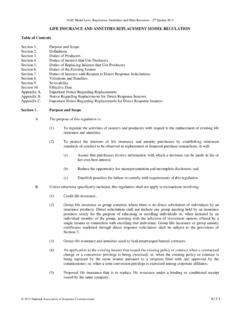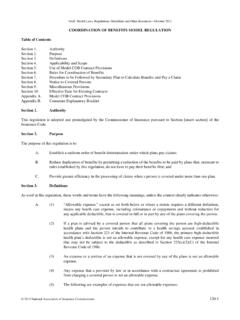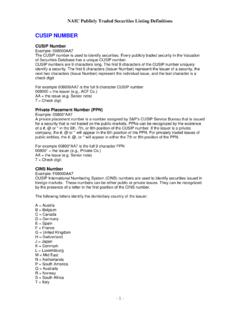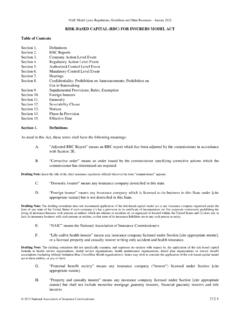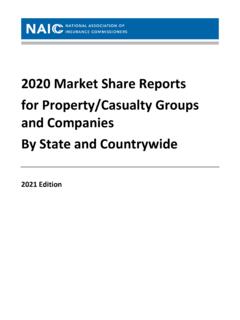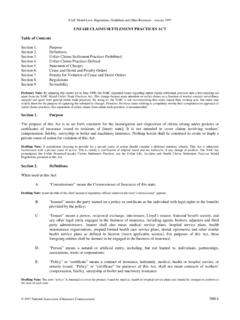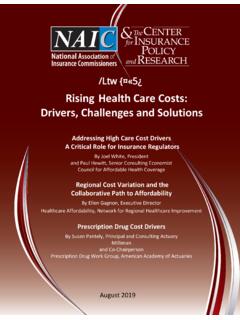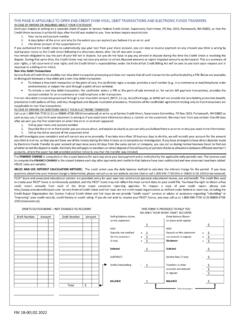Transcription of SUITABILITY IN ANNUITY TRANSACTIONS MODEL …
1 NAIC MODEL Laws, Regulations, Guidelines and Other Resources Spring 2020 2020 National Association of Insurance Commissioners 275-1 SUITABILITY IN ANNUITY TRANSACTIONS MODEL REGULATION Table of Contents Section 1. Purpose Section 2. Scope Section 3. Authority Section 4. Exemptions Section 5. Definitions Section 6. Duties of Insurers and Producers Section 7. Producer Training Section 8. Compliance Mitigation; Penalties; Enforcement Section 9. Recordkeeping Section 10. Effective Date Appendix A. Insurance Agent (Producer) Disclosure For Annuities Appendix B. Consumer Refusal to Provide Information Appendix C. Consumer Decision to Purchase an ANNUITY Not Based on a Recommendation Section 1. Purpose A. The purpose of this regulation is to require producers, as defined in this regulation, to act in the best interest of the consumer when making a recommendation of an ANNUITY and to require insurers to establish and maintain a system to supervise recommendations so that the insurance needs and financial objectives of consumers at the time of the transaction are effectively addressed.
2 B. Nothing herein shall be construed to create or imply a private cause of action for a violation of this regulation or to subject a producer to civil liability under the best interest standard of care outlined in Section 6 of this regulation or under standards governing the conduct of a fiduciary or a fiduciary relationship. Drafting Note: The language of Subsection B comes from the NAIC Unfair Trade Practices Act (#880). If a state has adopted different language, it should be substituted for Subsection B. Drafting Note: Section 989J of the Dodd-Frank Wall Street Reform and Consumer Protection Act of 2010 ( Dodd-Frank Act ) specifically refers to this MODEL regulation as the SUITABILITY in ANNUITY TRANSACTIONS MODEL Regulation (#275). Section 989J of the Dodd-Frank Act confirmed this exemption of certain annuities from the Securities Act of 1933 and confirmed state regulatory authority.
3 This regulation is a successor regulation that exceeds the requirements of the 2010 MODEL regulation. Section 2. Scope This regulation shall apply to any sale or recommendation of an ANNUITY . Section 3. Authority This regulation is issued under the authority of [insert reference to enabling legislation]. Drafting Note: States may wish to use the Unfair Trade Practices Act (#880) as enabling legislation or may pass a law with specific authority to adopt this regulation. Section 4. Exemptions Unless otherwise specifically included, this regulation shall not apply to TRANSACTIONS involving: A. direct response solicitations where there is no recommendation based on information collected from the consumer pursuant to this regulation; B. Contracts used to fund: (1) An employee pension or welfare benefit plan that is covered by the Employee Retirement and Income Security Act (ERISA); SUITABILITY in ANNUITY TRANSACTIONS MODEL Regulation 275-2 2020 National Association of Insurance Commissioners (2) A plan described by Sections 401(a), 401(k), 403(b), 408(k) or 408(p) of the Internal Revenue Code (IRC), as amended, if established or maintained by an employer; (3) A government or church plan defined in section 414 of the IRC, a government or church welfare benefit plan, or a deferred compensation plan of a state or local government or tax-exempt organization under Section 457 of the IRC; or (4) A nonqualified deferred compensation arrangement established or maintained by an employer or plan sponsor.
4 C. Settlements of or assumptions of liabilities associated with personal injury litigation or any dispute or claim resolution process; or D. Formal prepaid funeral contracts. Section 5. Definitions A. ANNUITY means an ANNUITY that is an insurance product under state law that is individually solicited, whether the product is classified as an individual or group ANNUITY . B. Cash compensation means any discount, concession, fee, service fee, commission, sales charge, loan, override, or cash benefit received by a producer in connection with the recommendation or sale of an ANNUITY from an insurer, intermediary, or directly from the consumer. C. Consumer profile information means information that is reasonably appropriate to determine whether a recommendation addresses the consumer s financial situation, insurance needs and financial objectives, including, at a minimum, the following: (1) Age; (2) Annual income; (3) Financial situation and needs, including debts and other obligations; (4) Financial experience; (5) Insurance needs; (6) Financial objectives; (7) Intended use of the ANNUITY ; (8) Financial time horizon; (9) Existing assets or financial products, including investment, ANNUITY and insurance holdings; (10) Liquidity needs; (11) Liquid net worth; (12) Risk tolerance, including but not limited to, willingness to accept non-guaranteed elements in the ANNUITY ; (13) Financial resources used to fund the ANNUITY .
5 And (14) Tax status. D. Continuing education credit or CE credit means one continuing education credit as defined in [insert reference in state law or regulations governing producer continuing education course approval]. NAIC MODEL Laws, Regulations, Guidelines and Other Resources Spring 2020 2020 National Association of Insurance Commissioners 275-3 E. Continuing education provider or CE provider means an individual or entity that is approved to offer continuing education courses pursuant to [insert reference in state law or regulations governing producer continuing education course approval]. F. FINRA means the Financial Industry Regulatory Authority or a succeeding agency. G. Insurer means a company required to be licensed under the laws of this state to provide insurance products, including annuities.
6 H. Intermediary means an entity contracted directly with an insurer or with another entity contracted with an insurer to facilitate the sale of the insurer s annuities by producers. I. (1) Material conflict of interest means a financial interest of the producer in the sale of an ANNUITY that a reasonable person would expect to influence the impartiality of a recommendation. (2) Material conflict of interest does not include cash compensation or non-cash compensation. J. Non-cash compensation means any form of compensation that is not cash compensation, including, but not limited to, health insurance, office rent, office support and retirement benefits. K. Non-guaranteed elements means the premiums, credited interest rates (including any bonus), benefits, values, dividends, non-interest based credits, charges or elements of formulas used to determine any of these, that are subject to company discretion and are not guaranteed at issue.
7 An element is considered non-guaranteed if any of the underlying non-guaranteed elements are used in its calculation. L. Producer means a person or entity required to be licensed under the laws of this state to sell, solicit or negotiate insurance, including annuities. For purposes of this regulation, producer includes an insurer where no producer is involved. M. (1) Recommendation means advice provided by a producer to an individual consumer that was intended to result or does result in a purchase, an exchange or a replacement of an ANNUITY in accordance with that advice. (2) Recommendation does not include general communication to the public, generalized customer services assistance or administrative support, general educational information and tools, prospectuses, or other product and sales material.
8 N. Replacement means a transaction in which a new ANNUITY is to be purchased, and it is known or should be known to the proposing producer, or to the proposing insurer whether or not a producer is involved, that by reason of the transaction, an existing ANNUITY or other insurance policy has been or is to be any of the following: (1) Lapsed, forfeited, surrendered or partially surrendered, assigned to the replacing insurer or otherwise terminated; (2) Converted to reduced paid-up insurance, continued as extended term insurance, or otherwise reduced in value by the use of nonforfeiture benefits or other policy values; (3) Amended so as to effect either a reduction in benefits or in the term for which coverage would otherwise remain in force or for which benefits would be paid; (4) Reissued with any reduction in cash value; or (5) Used in a financed purchase.
9 Drafting Note: The definition of replacement above is derived from the NAIC Life Insurance and Annuities Replacement MODEL Regulation (#613). If a state has a different definition for replacement, the state should either insert the text of that definition in place of the definition above or modify the definition above to provide a cross-reference to the definition of replacement that is in state law or regulation. SUITABILITY in ANNUITY TRANSACTIONS MODEL Regulation 275-4 2020 National Association of Insurance Commissioners O. SEC means the United States Securities and Exchange Commission. Section 6. Duties of Insurers and Producers A. Best Interest Obligations. A producer, when making a recommendation of an ANNUITY , shall act in the best interest of the consumer under the circumstances known at the time the recommendation is made, without placing the producer s or the insurer s financial interest ahead of the consumer s interest.
10 A producer has acted in the best interest of the consumer if they have satisfied the following obligations regarding care, disclosure, conflict of interest and documentation: (1) (a) Care Obligation. The producer, in making a recommendation shall exercise reasonable diligence, care and skill to: (i) Know the consumer s financial situation, insurance needs and financial objectives; (ii) Understand the available recommendation options after making a reasonable inquiry into options available to the producer; (iii) Have a reasonable basis to believe the recommended option effectively addresses the consumer s financial situation, insurance needs and financial objectives over the life of the product, as evaluated in light of the consumer profile information; and (iv) Communicate the basis or bases of the recommendation.
